
It allows to keep PV going, with more focus towards AI, but keeping be one of the few truly independent places.
-
The 1/2-inch format has an image circle diameter of 8 mm, which is very close to the GH2's 1080 ETC-mode diagonal of 8.3 mm.
1/2-inch format ENG lenses are made for 3-CCD cameras. The standard specifies an amount of glass behind the lens for the prism and color filters. It also specifies slightly different flange focal distances for green than for red and for blue. Since the GH2 has no prism and has its color sensors all in the same plane, these lenses are not perfectly matched for the GH2. In my testing, at wide aperture settings the image becomes hazy due to some focus aberration - I'm guessing mostly because of the absence of glass behind the lens. Stopping down to f/4 or so mostly fixes the haziness. In theory, the lack of glass behind the lens could be corrected with nothing more than a flat block of glass between the lens and the sensor. It would take more complicated optics to correct for the differences in the flange focal distances of the different colors, but I don't expect the longitudinal chromatic aberration to be very bad if this weren't corrected.
There are two 1/2-inch mounts: standard, and Sony. Most 1/2-inch lens models were made in both mounts. About two thirds of the used lenses for sale are in standard mount, and one third in Sony mount. I have attached sample images of the different mounts. The standard mount has a flange focal distance of 35.74 mm. The Sony mount has a flange focal distance of 38 mm.
ciecio7 on eBay makes a 1/2-inch Sony mount to Micro Four Thirds adapter: http://en.foto-akcesoria.com.pl/index.php/shop/product?idproduct=321&productname=1-2-quot-38-mount-mft
He also had a 1/2-inch standard mount to Micro Four Thirds adapter listed for sale, but I ordered the adapter and it was wrong. I'm sending my adapter back, but I'm sure someone could work with him to get him the proper specifications for a 1/2-inch standard mount adapter. The 1/2-inch standard mount is quite similar to the 2/3-inch B4 mount, except with a different flange focal distance. He already makes 2/3-inch B4 mount adapters.
Canon 1/2-inch ENG lens models:
- KH: portable high def
- H: portable
- PH: studio/field
YH: portable pro standard def and pre-HD (semi-pro)
SX or SY in the servo unit model number indicates a Sony interface. IX, HX, or BX indicates a standard interface.
Fujinon 1/2-inch ENG lens models:
- HS: premiere series high def, standard mount
- HSs: premiere series high def, Sony mount
- ZS: high def, standard mount
- XS: high def, Sony mount
S: standard def and pre-HD
-38, -D38, -18, or -D18 suffix in the servo unit model number indicates a Sony interfaces. Suffixes with other numbers usually indicate a standard interface.
Standard definition lenses in most cases are more than capable of delivering HD resolutions, though not necessarily across the entire frame and at all focal lengths and aperture settings. HD lenses are made to a higher standard, and they cost a lot more.
References:
http://www.cinematography.net/edited-pages/HDLensesOnFilmCameras.htm
http://tech.ebu.ch/docs/tech/tech3294.pdf
http://www.usa.canon.com/CUSA/assets/app/pdf/whitepaper/bctv/2.3InTriImager08.pdf
http://www.usa.canon.com/CUSA/assets/app/pdf/bctv/CanonMarch06WhitePaper.pdf
http://www.usa.canon.com/CUSA/assets/app/pdf/bctv/Whitepaper_Revised.pdf
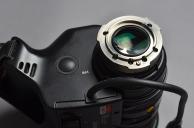
 1-2 standard mount (JVC, Panasonic).jpg883 x 582 - 99K
1-2 standard mount (JVC, Panasonic).jpg883 x 582 - 99K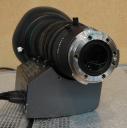
 1-2 Sony mount, passive.jpg1587 x 1600 - 517K
1-2 Sony mount, passive.jpg1587 x 1600 - 517K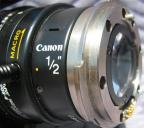
 1-2 Sony mount, active.jpg779 x 691 - 80K
1-2 Sony mount, active.jpg779 x 691 - 80K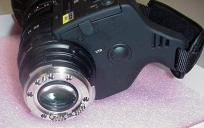
 1-2 Sony mount, active (2).jpg496 x 311 - 39K
1-2 Sony mount, active (2).jpg496 x 311 - 39K -
ENG lenses are made for shooting video:
large zoom ratio
constant brightness (f-number) across the zoom range
parfocal (holds focus distance across the zoom range)
smooth controls
gears, for a servo controller or follow focus
back focus adjustment
It's a treat to shoot video with a good video zoom lens, instead of using lenses designed primarily for photography. Most of the SD and pre-HD 1/2-inch lenses can be had for less than $100 or $200 on eBay. Lenses are f/1.4 unless stated otherwise. (Note that the minimum f-number only applies to the first half or so of the zoom range. At the long end, the minimum f-number usually goes up by about a stop)
Canon SD and pre-HD models:
H9ax3.8 I
H15ax6 I (internal focus, doubler)
H20ax6 I (internal focus, doubler)
PH10x8B
PH12x7.5B
PH14AX6.6B I (internal focus, doubler)
PH15x7B
PH15x7B I (doubler)
YH13x7.5
YH14x7.3
YH16x7 f/1.9 (internal focus)
YH17x7
YH18x6.7 K (internal focus)
YH18x6.7 I (internal focus, doubler)
YH19x6.7 K (internal focus)
YH19x6.7 I (internal focus, doubler)
Fujinon SD and pre-HD models:
S12x7.5 (older)
S13x4.6 (newest) f/1.5
S14x6.2 (older, doubler)
S14x6.6 BERM (older, doubler)
S14x6.6 BEVM (newer, doubler)
S14x7.3 f/1.9
S14X7.5 BRM-4 (newer)
S15x6.1 (newest, internal focus, doubler)
S16x6.7 (newer)
S16x7 (older)
S16x7.3 f/1.9 (newer)
S16x7.3 f/1.9 (newer, internal focus)
S17x6.6 f/1.5 (newest, internal focus)
S18x6.7 (newer)
S19x6.5 (newest, internal focus)
S19x6.5 E (newest, internal focus, doubler)
S20x6.4 (newest, internal focus)
eBay searches:
-
I am planing on getting an ENG lens, but am confused on the best rout to take. Would a 2/3 inch be better? Do you have to use the ETC TEL Conversion? I have both GH2 & 3. Would like to be able to use these kind of lenses. Do you need a doubler? can you not use it? I keep reading conflicting stuff. Like they really are around F4 after you use the doubler and that you have to use one. Others say no you can use it without as long as its a 2/3s.
-
Bayonet-mount ENG lenses, be they 2/3" B4 mount lenses or 1/2" lenses, are designed for cameras with prism optic beam splitters and 3 CCDs. Single sensor cameras like the GH2 and GH3 don't have that chunk of glass, so these lenses don't perform very well. You have to reduce the aperture size by several stops to get rid of the haziness. For that reason alone, I have no interest in the bayonet-mount ENG lenses. If you really don't need large aperture settings, the bayonet-mount ENG lenses are alright. A 2/3" lens can be used with a built-in 2x extender (on the lenses that have them) to cover the 4/3" sensor, though the performance of a 2x extender used this way is not excellent. The doublers are not designed to cover anything more than 2/3", so the picture gets soft outside of that central 2/3" portion of the image. You can always use a 2/3" or 1/2" lens in ETC mode, though, and get a sharper picture in the corners without any need for a 2x extender.
Employing a 2x extender doubles the f-number as well as the focal length. You don't get something for nothing. An extender doesn't make your lens bigger. It just magnifies and enlarges the image that it projects, which of course makes the image darker. Using 1080 ETC mode has a similar penalty for noise performance: on the GH2 it's equivalent to a 2.6x extender, and 2.4x on the GH3.
You can use a 2/3" B4 mount 3-CCD ENG lens with a converter that optically corrects for the missing prism. But those adapters cost $1500 and up. It's probably the best solution if you are dead set on using the GH2 or GH3 and you have more money than time.
C-mount lenses for single chip 1/2" or 2/3" sensors are another option. They need to be used with ETC mode. 1/2" format covers 1080 ETC mode 96% (i.e. close enough), and 2/3" format covers it 133% (i.e. more than enough, and your angle of view won't be quite as wide as it would be on an actual 2/3" camera) But the best performing C-mount zoom lenses require modification to fit in an m43 adapter. 1" zoom lenses will also work, but they don't fully cover the 4/3" sensor, so you will need to crop and lose some resolution. 1/3" lenses provide good coverage for 720 ETC mode, if you can live with the lower resolution.
There is no really good solution here. You need to spend some time or money, or think about a different kind of camera.
-
Thank you for an excellent review of these lens options
-
@Balazar, Thanks for this - very informative.
You said the standard 1/2" adapter being offered on eBay was 'wrong' - it what way was that, and do you know if this has been corrected now?
I picked up a Fujinon ENG lens with an extender, and comparing it to the Sony mount Canon lens we have at work, it's definitely different, so I guess I'm safe to assume this is a standard mount?
Lining it up on the bench with my AF101 it appears to fill most, if not all of the sensor, but having picked up the lens for £25, I'm not sure I want to spend nearly ten times that on an adapter until I'm sure it's going to be OK!
Does the fact that this Polish adapter seems to be the only one available suggest that using 1/2" lenses on M4/3 is maybe not such a good idea? And you say the 1/2" mount is quite close to the B4 2/3" standard - probably a silly question, but close enough to adapt? You can pick up the 2/3" adapters a lot cheaper than this 1/2" one…
The lens is a Fujinon Lynx III S18x6.4 BERM, btw.
-
The 1/2-inch standard mount to Micro Four Thirds adapter that ciecio7 sent me was basically using the Sony mount but the standard flange focal distance, which is wrong. I have no idea if he has made a correct adapter since then. I do see something on his web site and it looks different from the Sony adapter, but you'd have to ask him. He's a smart guy and I'm confident that he could make the correct adapter with some guidance.
I've attached photos of the standard 1/2 and Sony 1/2 mounts. The location of the alignment pin is the easiest way to spot the difference.
A 1/2-inch lens's image circle is less than half the diameter necessary to cover the AF101's four thirds sensor, so they're not matched at all. Coverage is largest at the longest end and smallest 10 or 15% from the short end. A 1/2-inch lens has good coverage for the GH2 and GH3 in 1080 ETC mode. Personally I lost interest in these ENG lenses a long time ago when I discovered the poor performance at wide aperture settings due to the absence of a beam splitting prism in our cameras.
With the GH4 on the horizon, C-mount zooms get even better: easy-to-find and easily adapted 2/3-inch lenses cover 2560 x 1440 video resolution, which you can downsample to 1080p. Avoid the f/1.2 lenses, most of which won't fit an m43 adapter. The most common 6x f/1.4 or slower 2/3-inch lenses will work, and you'll find them easily from Fujinon, Computar, and many other names. Search for 12.5-75 lenses on eBay and look for the all-manual ones, and you'll be off to a great start.
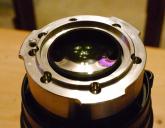
 canon-half-inch-lens-mount.jpg2000 x 1556 - 1M
canon-half-inch-lens-mount.jpg2000 x 1556 - 1M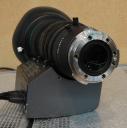
 1-2 Sony mount, passive.jpg1587 x 1600 - 517K
1-2 Sony mount, passive.jpg1587 x 1600 - 517K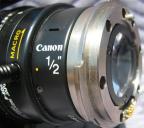
 1-2 Sony mount, active.jpg779 x 691 - 80K
1-2 Sony mount, active.jpg779 x 691 - 80K -
Rather than risk nearly £200 on an adapter for a lens that might not be worth it, I bodged up my own, by cutting down a m4/3 macro tube. I had a cheap set of extension tubes kicking about and found that the bayonet flange from the lens almost fit inside. I took the flange off the lens to use as a pattern to cut slots for the lugs, then ground out the tube with a rotary file until it was a snug fit - not exactly precision engineering, but it worked better than I expected, and I've always got another section of tube left to take to my friendly machinist to make something a bit better. And of course that's a lot of weight, even with the zoom servo removed, to be hanging off an adapter with no lens support, so it's not a field-ready solution, just something for testing with.
Bearing in mind that there were almost certainly some leaks and internal reflections, the results were mixed, so I'm going to have to do some more testing before I pronounce judgement and post some footage. At the moment, I'm thinking it's more a 'character' lens than the practical jack-of-all-trades that you'd want from an ENG lens. There's some definite colour fringing when you're zoomed right in, it's a bit soft at wider apertures and it vignettes below about half-way, but there are areas where it performs quite well. Anyway, I wont be buying an adapter yet, if at all, but I think I'll get a better version of my home-made one machined and see how that works out.
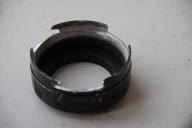
 P1020726.jpg1280 x 853 - 639K
P1020726.jpg1280 x 853 - 639K
 P1020725.jpg1280 x 853 - 982K
P1020725.jpg1280 x 853 - 982K
 P1020722.jpg1280 x 853 - 1M
P1020722.jpg1280 x 853 - 1M
Howdy, Stranger!
It looks like you're new here. If you want to get involved, click one of these buttons!
Categories
- Topics List23,970
- Blog5,724
- General and News1,346
- Hacks and Patches1,153
- ↳ Top Settings33
- ↳ Beginners255
- ↳ Archives402
- ↳ Hacks News and Development56
- Cameras2,360
- ↳ Panasonic990
- ↳ Canon118
- ↳ Sony155
- ↳ Nikon96
- ↳ Pentax and Samsung70
- ↳ Olympus and Fujifilm100
- ↳ Compacts and Camcorders300
- ↳ Smartphones for video97
- ↳ Pro Video Cameras191
- ↳ BlackMagic and other raw cameras117
- Skill1,961
- ↳ Business and distribution66
- ↳ Preparation, scripts and legal38
- ↳ Art149
- ↳ Import, Convert, Exporting291
- ↳ Editors191
- ↳ Effects and stunts115
- ↳ Color grading197
- ↳ Sound and Music280
- ↳ Lighting96
- ↳ Software and storage tips267
- Gear5,414
- ↳ Filters, Adapters, Matte boxes344
- ↳ Lenses1,579
- ↳ Follow focus and gears93
- ↳ Sound498
- ↳ Lighting gear314
- ↳ Camera movement230
- ↳ Gimbals and copters302
- ↳ Rigs and related stuff272
- ↳ Power solutions83
- ↳ Monitors and viewfinders339
- ↳ Tripods and fluid heads139
- ↳ Storage286
- ↳ Computers and studio gear560
- ↳ VR and 3D248
- Showcase1,859
- Marketplace2,834
- Offtopic1,319



